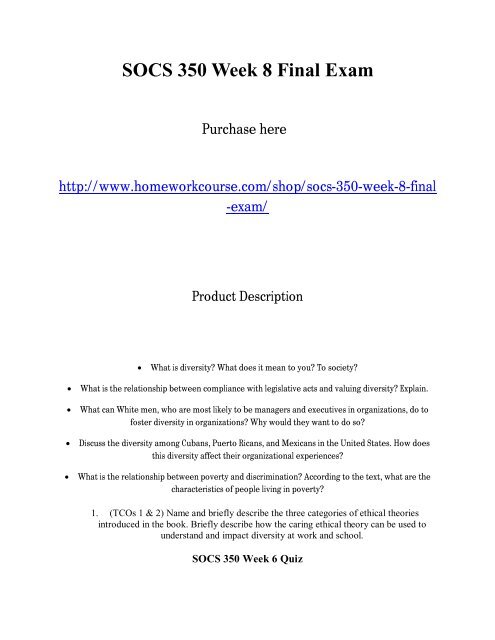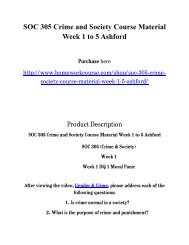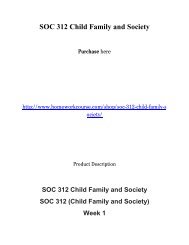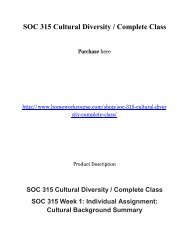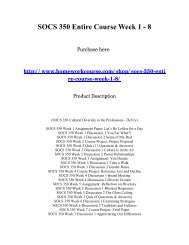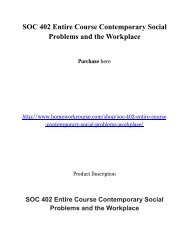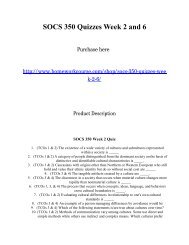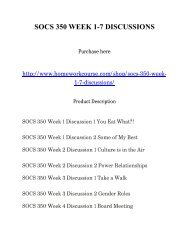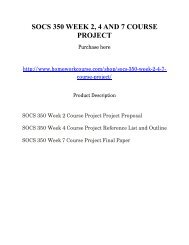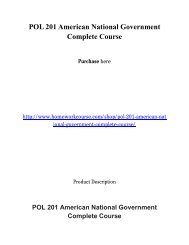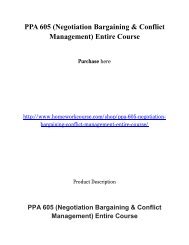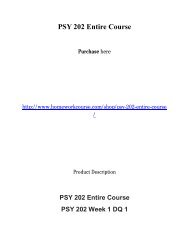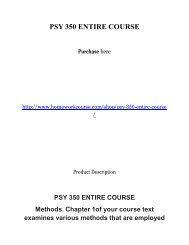SOCS 350 Week 8 Final Exam
Create successful ePaper yourself
Turn your PDF publications into a flip-book with our unique Google optimized e-Paper software.
<strong>SOCS</strong> <strong>350</strong> <strong>Week</strong> 8 <strong>Final</strong> <strong>Exam</strong><br />
Purchase here<br />
http://www.homeworkcourse.com/shop/socs-<strong>350</strong>-week-8-final<br />
-exam/<br />
Product Description<br />
<br />
What is diversity? What does it mean to you? To society?<br />
<br />
<br />
<br />
<br />
What is the relationship between compliance with legislative acts and valuing diversity? Explain.<br />
What can White men, who are most likely to be managers and executives in organizations, do to<br />
foster diversity in organizations? Why would they want to do so?<br />
Discuss the diversity among Cubans, Puerto Ricans, and Mexicans in the United States. How does<br />
this diversity affect their organizational experiences?<br />
What is the relationship between poverty and discrimination? According to the text, what are the<br />
characteristics of people living in poverty?<br />
1. (TCOs 1 & 2) Name and briefly describe the three categories of ethical theories<br />
introduced in the book. Briefly describe how the caring ethical theory can be used to<br />
understand and impact diversity at work and school.<br />
<strong>SOCS</strong> <strong>350</strong> <strong>Week</strong> 6 Quiz
1. (TCOs 6 & 7) Why is the following statement false? You can easily figure out how to<br />
communicate with your coworkers as long as you know their ethnicity.<br />
2. (TCOs 6 & 7) Millennial workers (1980–2000) tend to be motivated by<br />
3. (TCOs 6 & 7) The term white privilege means that<br />
4. (TCOs 4 & 7) Something that can generate ethnocentric responses or defensive reactions,<br />
such as voice, appearance, attitude, or behavior, is called _________.<br />
5. (TCOs 4 & 7) Time and manners are examples of this type of trigger:<br />
6. (TCO 8) The social position in life that comes as a result of behavior or things that happen<br />
over which one has no control (race, gender, and so on) is called _____.<br />
7. (TCOs 4, 5, & 7) What organizational strategies can be put in place to demonstrate that<br />
diversity is valued and to promote a culture of nondiscrimination? Discuss two specific<br />
ways in which organizations can accomplish these goals.<br />
8. (TCO 8) From the reading in Chapter 14, briefly describe general racial disparities and<br />
inequities that exist in the workplace, education, and justice system. How can these<br />
disparities be removed?


